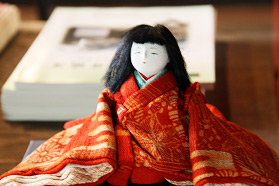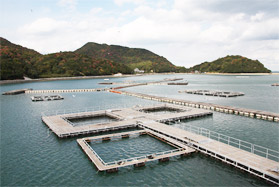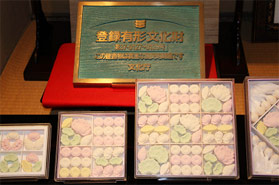
Although the winter of Sanuki is warm, this season when the kotatsu is warm is nice. Why don't you visit many old towns in Kagawa Prefecture, where you can warm up like a winter dawn. Higashi-Kagawa City, the eastern end of Kagawa Prefecture, has a port town that boasts a proudly protected townscape. Hikita was once known as a port waiting for the wind. Therefore, this time we will introduce the town of Hikita, which is famous for the early spring doll festival.
A row of medieval castle towns

Hikida, Higashikagawa is located at the eastern entrance of Kagawa Prefecture, and its history has long been known as a key point of transportation. In the Middle Ages, Hikita Castle was built, and commercial development eventually flourished. In the Edo period, homes to Australian merchants such as soy sauce brewing and shipping companies were lined up. Even now, the buildings from Edo to Meiji still remain, giving a nostalgic atmosphere.
The building that represents this town is Sanshu Izutsu Yashiki. One of the Hikita Osanke family, which has prospered since ancient times in the soy sauce and sake brewing industries, and is now known as a tourist base in Hikita. Town walks and other events are taking place on the streets of the Izutsu-yashiki and the good old town, but the most famous ones are from late February to early March (2, February 3 to March 2009). The "Hikita Doll Festival" is held. Each house is decorated with dolls, etc., and you can see the entrance and the parlor. Hina doll making corner, tea ceremony, check-in procession, and town bazaar are also held, and the area around Hikita Station is gorgeous.
NPO Higashikagawa New Tourism Association Telephone 0879-23-8557
Aussie Life “Sanshu Izutsu Yashiki”

About 5 minutes on foot from JR Hikida Station, there is Sanshu Izutsu Yashiki, the base of the old town. First, visit the main building. Spacious bookstores, gardens with the theme of "bridge", stately Japanese-style rooms, elaborately decorated tea rooms, etc., prospered through the brewing of soy sauce and sake that had been known until the Kanto period in the Genroku period. You can get a glimpse of the life of Australian merchants. Tour is charged, but take a break as tea is provided.
It is also a base for volunteer guides, from 12:15 to 10:15 on weekdays and Saturdays. On Sundays, from XNUMXam to XNUMXpm, a free guide to Izutsu-yashiki is provided to those who wish. (Advance reservation required: Please contact the "Higashi-Kagawa City New Tourism Association.")
Mansion shop guide

Let's take a look at the shops inside the Izutsu mansion. After passing through the gate, there is a main building on the right and Ichinokura on the left has "rice and soy sauce". You can enjoy Japanese food using local ingredients in a calm atmosphere like a private house. It is a push for lunch, but it will respond if you make a reservation at night. (Telephone 0879-33-3660 closed on Wednesday)
Located in Ninokura is Antique Miyake. At the end of the year, items related to Kagawa Prefecture will be lined up, and from the beginning of the year, gem related to chicks. For those who are worried about buying antiques, it seems that there is a guarantee that if they are fake, they will buy them at the selling price. Bargain items such as scrolls, dolls, and vessels are lined up in good condition. (Telephone 0879-33-6280 Closed Wednesday)
On the first floor of Sannokura, there is the “Takumi no Product Center” on the first floor where you can find Higashi Kagawa's “Eemon”. Check here for souvenirs such as gloves, Wasanbon, soy sauce, seafood, and famous confections. (Telephone 0879-23-8550 closed on Wednesday)
Don't forget to go up to the second floor of Sannokura. There is a "glove workshop" here. There is an experience corner for making original key chains and original gloves using the peeling of the skin (pay, weekdays, Saturdays, groups need reservations), and the only my gloves in the world will be born under the guidance of experienced seamstress. In addition, we accept order of various gloves, but this fits into hand well and is the best! Recommended for Hikita's memories. (Reservation Telephone Co., Ltd. Ooogi 0879-33-6890 Wednesday closed)
Yonokura is used as a rental facility during events, such as an experience corner. Gonokura is followed by “Iroha Noi”, a shop with accessories and clothes with cute Japanese patterns and “MOKA & NOVA” a green shop, and a rare beetle and stag beetle shop “Kabukuwa Yamato.com” (telephone 090-5270-2036 Tue.・ Thursday, Saturday, Sunday, and public holidays). And there is a Chihuahua-only breeder's shop in Chiba, which is only here in Shikoku, and cute puppy clothes are also popular.
(Telephone 090-8287-5805, only on public holidays) Sanju Izutsu Yashiki is closed on Wednesdays and is open from 10:16 to XNUMX:XNUMX.
The year-end is closed only on the 31st and is open from January 1st, so be sure to stop by during the festive New Year holidays.
Area Guide
The area around Sanju Izutsu Yashiki is recommended for a stroll. See the gorgeous Nagayamon's eye-catching Shoya-yashiki, the Matsumura family who sold and dispensed herbal medicine, the Izumi family who sold marine products, etc. can do. Also, the modern post office building in the early Showa era, right next to Izutsu-yashiki, has been transformed into a cafe called "Café Nouvelle Post", and its curry set for lunch and cake set in the afternoon are popular.
(Telephone 0879-33-6881 Mon-Wed is a regular holiday)
The entire area of Higashikagawa City, including Hikita, has long been known as a glove producing area. As of November 2008, there are 11 glove companies in the city just belonging to the Japan Glove Industry Association. Among them, this time I visited two companies.
American department stores
The first thing I visited was "Fukuda Gloves Co., Ltd." near Hikita Hachimangu Shrine in Hikita. Founded in Taisho 2 and established in 31. We also handle products for public demand, and currently have production bases overseas and send many products to the Tokyo market. The main customers are wholesalers and department stores, and they also do business with US department stores. We think from the plan and sew according to the finally decided design, but he seems to be constantly devising to meet the demands of both design and functionality. (Phone 0879-33-3607)
Bridal gloves best in Japan

Next, "Ozzy Co., Ltd." is located at a location upstream from the center of Hikita, along the Magyuku River. The first bridal glove manufacturer in Japan, and still has the highest production volume in Japan for this market share. The glove design has changed due to the trend of dresses, and it is now shifting from popular lace to organdy and satin types. Utilizing its delicate sewing technology and design sense, we also handle custom-designed Japanese gloves, but these Japanese-patterned gloves are very popular at major department stores. It is said that foreigners often buy souvenirs, so they also offer big sizes. Oosie Co., Ltd. sells gloves and non-slip gloves and socks for caddies, and orders hats and bags. He said that he is still struggling with the unique product development today. (Phone 0879-33-2515)
Glove gallery is born
Oji's representative, Oaza positive number, is also the chairman of the Higashi Kagawa Glove Tourism Promotion Association. Next, I visited the “Gloves Gallery”, which just opened in November 2008 with the guidance of Oaza. The gallery just diagonally in front of Sanshu Izutsu Yashiki is a showcase of a glove factory in Showa, where young designers can get familiar with gloves. On this antique factory, you can meet various exciting art. The gloves are full of nostalgia and warm atmosphere.
Hikida is also a soy sauce production area. Seaside Hikita has been making salt since ancient times, and it was a source of high-quality salt and was suitable for soy sauce production. It is said that the brewing of soy sauce in Hikita-mura started almost at the same time as that of Shodoshima, and it developed greatly from the end of Kansei era in the Edo period to the cultural culture. So next, I visited the scent of soy sauce.
Soy Sauce Revolution "Soisolt"

Just northwest of Sanju Izutsu-yashiki, under Miyukibashi, there is a building of a registered tangible cultural property of a country with beautiful red bengalara. This is Kamebashiya, founded in 3. It is also known for keeping the manufacturing method with a history of more than two hundred years, "Koji method rather". The koji cultivated with great care is put into cedar tubs that are more than 1753 years old, carefully aged for two, three, or even ten years to produce deep-tasting soy sauce. When it came to my mind, I made soy sauce and moromi ice cream "Soy Gelato" and soy sauce freeze-dried "Soisolt". It can be easily sprinkled on meat, salads, pastas, etc. There are four types, such as "light" and "onion & garlic". This has won the Grand Prize at the 4 Kagawa Prefectural Goods Competition.

In addition, this Soisolt and Belgian chocolate made a shock encounter, and Soisochora was born. "Soy Chocolat" is also recommended for Valentine's Day, which has been praised by the chef of a three-star restaurant in France. Kamebishi also has a teahouse where you can taste soy gelato and other dishes, and a kameboshiya udon shop (open only on Saturdays, Sundays and holidays) where you can enjoy a special soy sauce.
Phone: 0879-33-2555 Toll-free: 0120-1753-25
Gallery of soy sauce brewery
Next, we visited the town corner gallery Yuyu, which is located between Hikita's main street, Honmachi-dori, which is home to the old townscape of Hikita Government Building. There used to be a soy sauce brewery here, but now it's beautifully arranged and a cute gallery where you can enjoy tea while watching the garden has been completed. Handmade dolls are also displayed at the Hinamatsuri, a stylish mansion that is crowded with many people. Hikida Shoyu was founded in the Edo era by a shipping wholesaler and started in the Meiji era. It became the first company in Hikita-cho in 4, but in 25, the company established the Okawa Shoyu Association from a trade association, and is currently engaged in joint purchase of raw materials and joint sale of products. It had a branch in Tokushima prefecture before the war, so there are many business partners in Tokushima prefecture, and the soy sauce soy sauce here is also used for Tokushima ramen and seems to be very popular. The soy sauce store is located along National Route 11 from JR Hikida Station to Takamatsu. (Phone Hikita soy sauce 0879-33-2565 Gallery 0879-33-6833)
Birthplace of hamachi farming
Hikida is also known as the birthplace of hamachi farming. 2008 is the 80th anniversary of hamachi farming. It was a memorable year for the 100th anniversary of the birth of Kazaburo Noami, who succeeded in this aquaculture. Wasaburo Noami, born in 41 as the third son of Amimoto in Hikita-mura, felt the harshness of a fisherman's life. In order to remove even that anxiety, I went to fisheries school and aimed for aquaculture. At the time, farming was all about freshwater fish. Speaking of culturing sea fish, it was a time of laughter, but after graduation, Wasaburo went to Ado Pond and in 1908, he succeeded in cultivating hamachi for the first time in the world.
Atoike pond fishing spot where hamachi springs

The Ato Pond is currently hosting a large number of anglers as a fishing spot "fish hook". You can experience sea fishing for released fish such as hamachi, amberjack, hiramasa, and Thailand, and it often costs big fish. (Closed on January 1st and 1nd, telephone 2-0879-33) On the shore of the pond is the "Experience Learning Center Marericco" (2800 yen entrance). This facility is also recommended for studying aquaculture and hamachi, and is used for hands-on school learning. From the second floor, you can also enjoy the beautiful scenery of Ado Pond, and experience the feeding of hamachi (¥ 100) and the fishing experience with a lender and a Thai fish (¥ 2). (Regular holidays are Tuesdays and New Year's holidays 200-1-500)
In addition, there is a local product exhibition and sales facility "Warsan". The first floor is lined with fresh hamachi, seafood and local souvenirs. The second floor is a dining room called “Wasantei”, where you can enjoy hamachi sashimi set meal only on Saturdays and Sundays, and yellowtail yellowtail sashimi set meal during the shipping period from October to the end of the year. (Regular holidays are Tuesdays and New Year's holidays by telephone 1-2-10)
Eco-friendly! Yellowtail yellowtail
One of the birthplaces of hamachi and now attracting attention is the "Hiketa yellowtail." Yellowtail is a succession fish whose name changes as it grows, and is called Mojako, Tubas, Hamachi, and Yellowtail. Hikita has developed a safe, secure, and healthy growing yellowtail as a “Hiketa yellowtail”, a regional brand fish that has been certified by the Japan Patent Office, by combining the farming techniques of 80 years since the success of hamachi cultivation.
Six kilometers off the coast of Hikita, we have created a vast cage that is 6m square and 25m deep, where we grow hamachi and yellowtail. Here, the sea environment is well protected, and first of all, don't overfeed. We also devise food that floats on the sea surface so that there is no leftover food. Winter fishing grounds once ship and empty all fish, during which time they grow nori and absorb the remaining nutrients in the sea. The bottom of the sea is cultivated so that oxygen can reach the bottom of the mud on the sea floor.
Recently, "Hiketa yellowtail" has been evaluated as "better than natural ones". (Inquiries: Hikida Fishery Cooperative Telephone 0879-33-2528)
Sashimi set meal

Next, we will introduce the shops in Hikita where you can enjoy "Hiketa Amber" and Hamachi. Along the Route 11 near the border of Tokushima, there is Sanukiya, a live fish dish. It is famous for eating fresh local fish, and it is a shop that is satisfying in both taste and volume for those who travel around the prefectural border for work. Here, you can enjoy the freshly sashimi of the hamachi (from October to the end of the year). Miso soup with plenty of seaweed is also delicious, and you can fully enjoy the seafood of Sanuki. (Regular holiday: December 10 telephone: 12-31-0879)
Very delicious hamachi soup bowl

Next time, we will visit "Momoyama Hirose Fresh Fish" on Honmachi Street again. The catering shop has an entrance on one of the eastern streets, and you can taste "Hamachi no Sukedon" with a reservation from two people to the day before. It seems that catering may not be able to meet the demands of the professional, but the taste is exquisite, and you can have it slowly in a parlor. "Hamachi no Suzudon" is a dish that has been trained in Kyoto, but who is not good at fish, but tries to eat delicious fish. That's why it's soaked in a secret sauce that is easy to eat and can be recommended to young fish-alikes. The container was emptied in no time. Recently there are reservations for group guests, and up to 2 people are OK. (Regular holiday: Monday: 50-0879-33)
Seto crepe and simmered

Hikita, blessed with seafood, has several seafood shops. I visited "Hamaura Marine Products" near the mouth of the Majuku River. We immediately process anchovies from Hikita offshore and send out delicious products. As it grows, it changes from white to white, chika, burrs, small wings, middle wings, and large wings (boiled and dried from small wings). If it is dried until it is dry, it becomes "boiled" and can be stored for a long time. Products carefully handmade with local ingredients can be eaten safely and deliciously. Orders by phone are OK, but they are also available at JA Ouchi Fureai City and Shunsaikan in Tokyo. (Phone 0879-33-3329)
Genuine, safe, healthy

We visited "Kimura Kaisan Co., Ltd." on the eastern side of the river bank upstream from the Magyado River. This business was founded in 37 with the main business of processing and selling Chirimenjako, which is landed mainly in the Seto Inland Sea. However, the sharp decline in fish catches caused a sense of crisis, and we quickly turned our eyes to overseas, cultivated purchasing routes, and worked to add value to products. Chirimenjako catches small fish at once, so there is a lot of fine garbage. We send out safe products by removing them one by one, but the technology of "Kimura Marine Products" that does not leave a single hair is regarded as the best in Japan. In other words, while maintaining the authentic taste of the tradition, we perform quality control with peace of mind using modern equipment, and produce health-oriented products with salt reduction technology that does not impair the taste. Kimura Kaisan, a product that also handles Iriko and sprinkles with plenty of calcium, is also used for sales at major supermarkets and for school lunches. It comes in a box, but you can sell it by phone or at a store. (Phone 0879-33-3141)
Ultimate sweets

Hikita has the world's ultimate sweets. Wasanbon is a sugar that is also used as a material for Japanese confectionery. Sugar polished by the traditional method of Edo and polished into a wooden frame, which makes it a lovely and beautiful tea candy. For the New Year's Day and the Doll's Festival, you should definitely use Wasanbon at Mitani Sugar, which crosses the Magusuku River and goes east on the national highway. Founded in the first year of culture (1804), both buildings and tools are designated as important tangible folk cultural properties of the country, and their manufacturing methods have not changed for 200 years. Its mellow mouth melting and elegant sweetness are the ultimate sweets of the world. This wassanbon, which was also popular at exhibitions of famous department stores, is located at Takamatsu Airport, Sanshu Izutsu-yashiki, and Shunsai-kan, but I would like to visit historic stores. (Phone 0879-33-2224)
A more delicious trip to Hikita
At the Sanju Izutsuji Mansion and the nearby Sanshu Kasaya House, there are a variety of handmade experience menus (paid). For example, you can also experience "Wasan Bon's die-cutting experience (reservation required)" and "Hirita's torashi candy making using soy sauce," "Udon making experience" and "Modern dressing experience" (Principle 2) Reservation required at least one day in advance). The “Hikita Ami Tour with a Guide”, where you can enjoy “Hamachi's soup bowl”, “Kamebashiya no udon”, and “Wasanbon chiffon cake”, is also very popular. Do you not enjoy in the town of Hikita on the day of waiting for spring?
Inquiry, application NPO East Kagawa-shi new tourism association Telephone 0879-23-8557
















 Olive products from Kagawa Prefecture
Olive products from Kagawa Prefecture




 Stores handling olive-related products
Stores handling olive-related products





